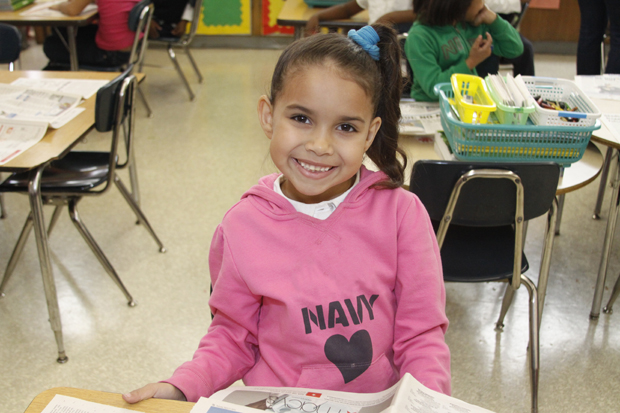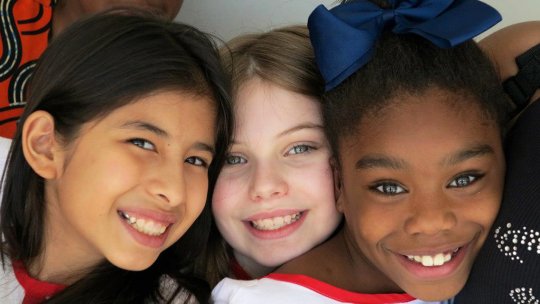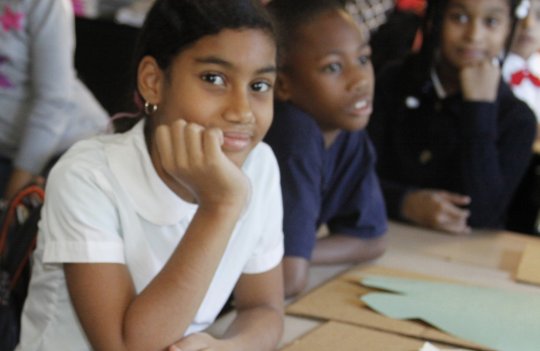Unit 2: Lesson 10
Introduce Part 2, Introduce Graphic Story Adventure Sequels & Begin Brainstorm
LITERACY OBJECTIVE
By the end of this lesson students will be able to identify the basic components of a sequel.
Literacy "I Can" Statements
"I can identify the basic components of a sequel."
Lesson Overview
| Steps |
Pacing: 45 Minutes |
|
|
15 Minutes |
|
|
30 Minutes |
STANDARDS ALIGNMENT
Reading: Literature
RL 3.9: Compare and contrast the themes, settings, and plots of stories written by the same author about the same or similar characters (e.g., in books from a series)
Reading: Literature
RL 4.9: Compare and contrast the treatment of similar themes and topics (e.g., opposition of good and evil) and patterns of events (e.g., the quest) in stories, myths, and traditional literature from different cultures.
RL 5.9: Compare and contrast stories in the same genre (e.g., mysteries and adventure stories) on their approaches to similar themes and topics.
Speaking & Listening
SL 3.1b: Follow agreed-upon rules for discussions (e.g., gaining the floor in respectful ways, listening to others with care, speaking one at a time about the topics and texts under discussion).
SL 3.1c: Ask questions to check understanding of information presented, stay on topic, and link their comments to the remarks of others.
SL 3.1d: Explain their own ideas and understanding in light of the discussion.
SL 3.2: Determine the main ideas and supporting details of a text read aloud or information presented in diverse media and formats, including visually, quantitatively, and orally.
SL 3.4: Report on a topic or text, tell a story, or recount an experience with appropriate facts and relevant, descriptive details, speaking clearly at an understandable pace.
SL 3.6: Speak in complete sentences when appropriate to task and situation in order to provide requested detail or clarification.
SL 4.1b: Follow agreed-upon rules for discussions and carry out assigned roles.
SL 4.1c: Pose and respond to specific questions to clarify or follow up on information, and make comments that contribute to the discussion and link to the remarks of others.
SL 4.1d: Review the key ideas expressed and explain their own ideas and understanding in light of the discussion.
SL 4.2: Paraphrase portions of a text read aloud or information presented in diverse media and formats, including visually, quantitatively, and orally.
SL 4.4: Report on a topic or text, tell a story, or recount an experience in an organized manner, using appropriate facts and relevant, descriptive details to support main ideas or themes; speak clearly at an understandable pace.
SL 4.6: Differentiate between contexts that call for formal English (e.g., presenting ideas) and situations where informal discourse is appropriate (e.g., small-group discussion); use formal English when appropriate to task and situation.
SL 5.1b: Follow agreed-upon rules for discussions and carry out assigned roles.
SL 5.1c: Pose and respond to specific questions by making comments that contribute to the discussion and elaborate on the remarks of others.
SL 5.1d: Review the key ideas expressed and draw conclusions in light of information and knowledge gained from the discussions.
SL 5.2: Summarize a written text read aloud or information presented in diverse media and formats, including visually, quantitatively, and orally.
SL 5.4: Report on a topic or text or present an opinion, sequencing ideas logically and using appropriate facts and relevant, descriptive details to support main ideas or themes; speak clearly at an understandable pace.
SL 5.6: Adapt speech to a variety of contexts and tasks, using formal English when appropriate to task and situation.
Teaching Resources
Unit 1 includes the following Life & Learning Skills:
-Reflective thinking
-Creative problem-solving
-Critical and analytic thinking
-Collaboration Communication
 Differentiation Options
Differentiation Options
Differentiation Options will appear throughout the unit to suggest ways to scaffold or challenge student learning. Use the number of helping hands to select the level of differentiation that best supports student learning.


 Highest level of scaffolding. Select this option if students are learning strategies for the first time, if the text is challenging for them, or if students require more guidance during activities. The Unit is written for the highest level of scaffolding.
Highest level of scaffolding. Select this option if students are learning strategies for the first time, if the text is challenging for them, or if students require more guidance during activities. The Unit is written for the highest level of scaffolding.

 Moderate scaffolding. Select this option if students require some support comprehending the text or navigating the activity.
Moderate scaffolding. Select this option if students require some support comprehending the text or navigating the activity.

Least amount of scaffolding/Extending the instruction. Select this option if students are ready to work more independently, move more quickly through the material, or are ready for additional challenge.
 Leveraging Moments
Leveraging Moments
Key instructional steps where the arts are used to leverage literacy-learning (and vice versa) are marked with  . Smaller leveraging moments also occur throughout the lessons.
. Smaller leveraging moments also occur throughout the lessons.
Process: Introduce Part 2 and review the Unit Overview for Students, which will help students know where they are in the learning process. Make decisions about how the class will develop the sequels for My Father’s Dragon and how each group will create its panel pages.
Part 2 lessons are written for a moderate level of scaffolding in which groups create graphic story sequels. See the Differentiation Options: Graphic Story Sequels menu for options for more or less scaffolding.
 Differentiation Options: Using an Alternate Text
Differentiation Options: Using an Alternate Text
This unit is written using My Father’s Dragon. Feel free to use an alternate text for Part 2.
See Unit 2 Text Selection for several alternate appropriate text recommendations.
Students can:
- Create a sequel for another adventure story.
- Create a graphic story representation of a different adventure story
- Write his or her own fantasy-adventure story and turn it into a graphic story
 Differentiation Options: Graphic Story Sequels
Differentiation Options: Graphic Story Sequels
The whole class brainstorms one graphic story sequel plan.
-- Students are put into groups of five. Each student creates panels for one event in the story.
OR
-- Each student creates his or her own graphic story.

 Groups:
Groups: Groups brainstorm their own graphic story sequel plan. With this option:
-- Each student creates panels for one event in the story.
OR
-- Each student creates his or her own graphic story.
 Students work independently:
Students work independently:Each student brainstorms his or her own graphic story sequel and creates graphic story panels.
Suggested Dialogue
Introduce Part 2 of Graphic Story Adventures!
"We’re starting Part 2 of the Graphic Story Adventures! unit, in which you’ll use your new graphic artist skills to create your own graphic story. Let’s visit the Unit Overview for Students, so we can see where we are in our process."
(Show Unit Overview for Students.)
"So far we have read an adventure story, visualized what we read, learned some drawing techniques, and learned how to tell stories like graphic artists. Next, we’ll create our own graphic story adventure using all the skills and techniques we’ve learned. The unit will culminate with a presentation of our published work for an invited audience" (school peers, friends, and family).
Process: Give an overview of the lesson objectives. Learn about sequels and brainstorm for the graphic story sequel to My Father’s Dragon.
Suggested Dialogue
"Today we begin brainstorming for our own graphic story adventure! By the end of today’s lesson, you will be able to say, 'I can identify the basic components of a sequel'.”
Process: Introduce and discuss sequels. Ask students what they know about sequels and give some examples.
Suggested Dialogue
"The graphic story adventure you’re going to create will be based on My Father’s Dragon. You are going to write a sequel to this story. "
"A sequel is a continuation of a book, play, or movie that extends the story. What can you tell me about sequels?" (Students respond.) "Some examples include Harry Potter, The Magic School Bus, and A Series of Unfortunate Events. Sequels are similar to the original story—they have the same main characters that go on new adventures and tackle new problems."
Process: Introduce the guidelines for creating a sequel to My Father’s Dragon.
Suggested Dialogue
Guidelines to create Graphic Story Sequels
"We will follow four guidelines to create our graphic story sequels":
- "Elmer and the dragon are the main characters."
- "They go to a new place."
- "They have a new problem to solve."
- "They pack four items in Elmer’s knapsack that help them solve the problem."
Process: Put students into graphic story sequel groups. There are many options for how to group students. Consider students’ understanding of story elements and graphic story elements and their skills as leaders and followers. Planning the sequel requires sharing ideas and negotiating final decisions for each event. Create groups of no more than five students.
Tell students where to go in the room and to bring their A4L Student Notebooks and pencils.
Process: Groups begin brainstorming their sequels by choosing a problem and items for Elmer’s knapsack that he will use to solve the problem. These choices can come from lists that are provided in the unit (see special menu Sequel Brainstorm Kick-off) or those generated by students. By selecting a problem and items for the knapsack, students have something to anchor them as they create their sequel plan so that the events are connected to the problem and lead to the resolution. See the special menu Sequel Kick-off Options to support selection organization. This unit is written for option 1—everything is randomly selected.
After students have selected their problem and knapsack items, have them record them on the Graphic Story Sequel Story Map on page 33 in their A4L Student Notebook.
Teaching Tip: Sequel Brainstorm Kick-off
Kick-off the brainstorm by giving groups a problem and list of knapsack items. Students can brainstorm additional problems and knapsack items. Feel free to modify.
Potential Problems
Elmer & the dragon might...
- Save the cat from pirates that captured her after Elmer left the docks.
- Save the dragon’s brother from the Island of Screaming Babies (or other island).
- Save a unicorn from having its wings clipped and put into a zoo.
- Save Elmer’s friend from a bully at school.
- Elmer’s town has been invaded by green tigers that will eat all the plants (or something else).
- Get caught by a giant octopus on their way home and need to find a way to escape.
- Get stuck on a snowy mountain on their way home.
Items for Elmer’s Knapsack
Pick four items...
Ski pole - Soccer ball -- Flippers
Rope - Tape measure -- Glue
Silly Putty - Tap shoes -- Play-Doh
Bananas - Jar of peanut butter -- Cookies
Umbrella - Magic plant seeds -- Skateboard
M&M’S (or other candy)
Music (genre, instrument, stereo, iPod)
Step Alternatives: Sequel Kick-off Options
Below are options for organizing groups to select problems and knapsack items.
- Everything is randomly selected
- Put problems in a hat, bowl, or envelope. Put knapsack items in a different hat, bowl, or envelope.
- Each group comes to the front of the room to draw its problem and four items.
- Problem is discussed & items are random
- Post problems on the board. Each group discusses and selects one of the problems.ut knapsack items in a hat, bowl, or envelope.
- Each group comes to the front of the room to draw four items.
- Problem is random & items are discussed:
- Put problems in a hat, bowl, or envelope and each group randomly selects, or the groups are randomly assigned a problem.
- Groups, with the problem in mind, pick four knapsack items from the list on the board.
- Students discuss & select everything:
- Post the list of problems and knapsack items on the board.
- Groups discuss and come to a consensus on their problem and four items.
Suggested Dialogue
"Open your A4L Student Notebooks to page 33. This is your Graphic Story Sequel Story Map. You’ll use this to brainstorm with your group about the events in your story."
"To get started, we’re going to do a random selection of problems and knapsack items that Elmer and the dragon take with them on their adventure. I’ll have you come up to the front of the room one group at a time to make your selections. Whatever you get is what you’ll base your graphic story adventure on. In this envelope I have many problems that Elmer and the dragon might encounter." (Hold up envelope.) "In this envelope I have many items that Elmer might pack in his knapsack." (Hold up another envelope.)
"Group 1, please come up to the front of the room to make your random selections. One of you, pull out a problem and announce it to the class." (Student selects and reads.) "May I have a different person pull out one item for the knapsack envelope." (Student selects and reads. Repeat process for remaining items and groups.)
"Now that we all have our problem and four knapsack items, record them on your Graphic Story Sequel Story Map."
Process: Close the lesson with a look forward describing the next lesson.
Suggested Dialogue
"In our next lesson, we will continue with the Graphic Story Sequel Story Maps and plan what happens for Elmer and the dragon in this new adventure."
Performing The Closing Ritual (Optional)
"To close our theater lessons, we'll appreciate our work and each other with a unified clap.
On three we'll all clap once and say, 'Huh!' 1-2-3 (clap) Huh!"
CONGRATULATIONS ON COMPLETING LESSON 10! YOU ARE NOW READY TO MOVE ONTO LESSON 11 OF UNIT 2.

 Differentiation Options
Differentiation Options ![]() Leveraging Moments
Leveraging Moments Differentiation Options: Using an Alternate Text
Differentiation Options: Using an Alternate Text  Differentiation Options: Graphic Story Sequels
Differentiation Options: Graphic Story Sequels 


